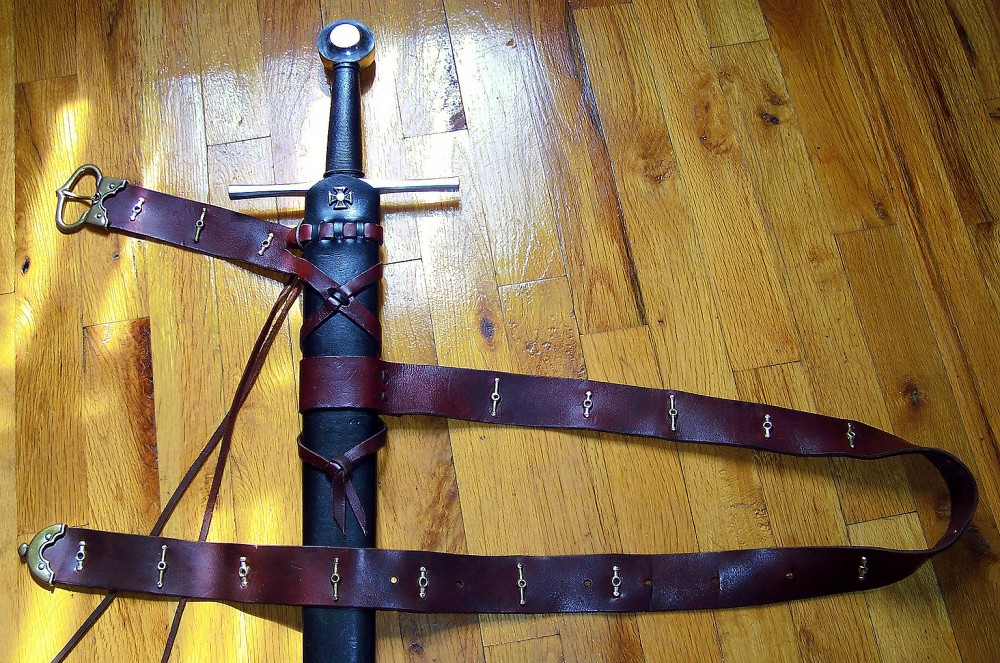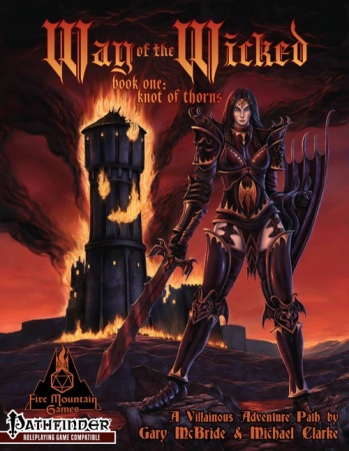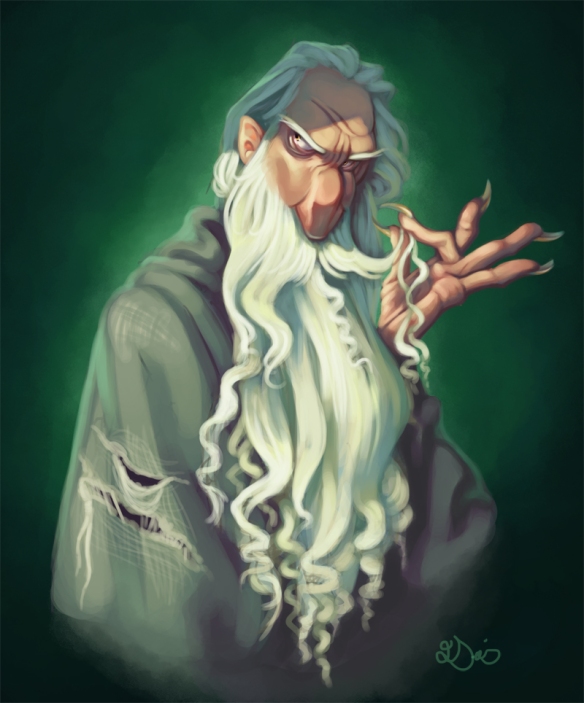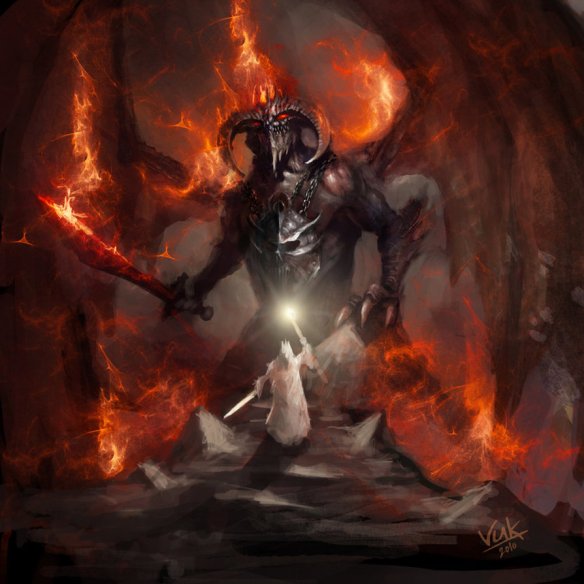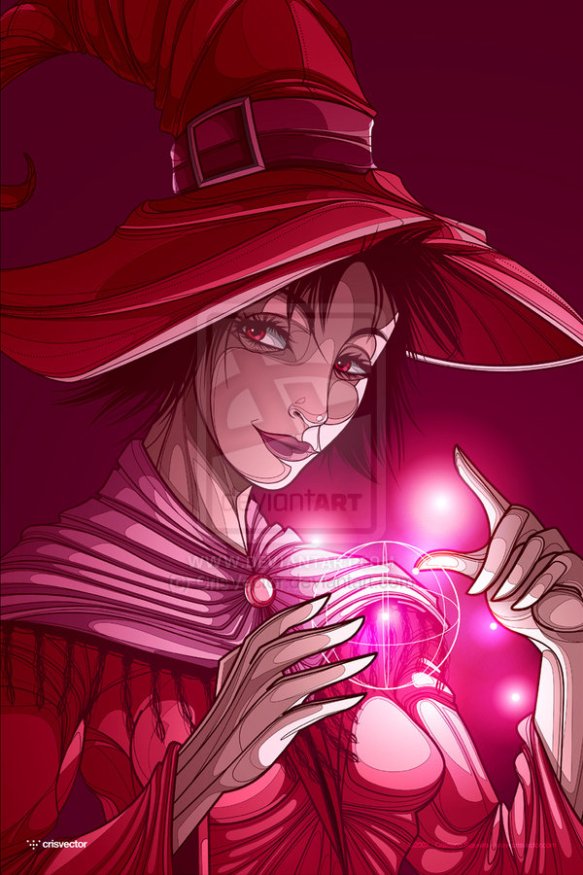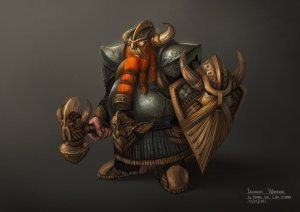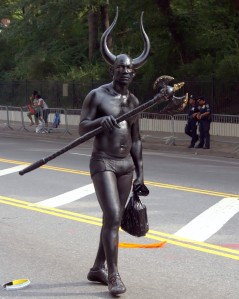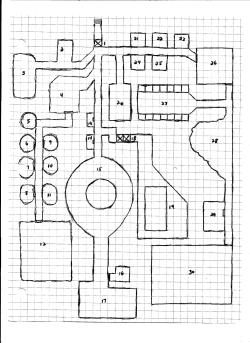Long before the first magus learned to blend martial prowess and studied magic into a single discipline, there existed an ancient elven order of elite arcane warriors whose members gained their arcane power as a result of intrinsic magic drawn from their blood and their souls, fusing it to devastating effect with their significant skill with bladed weapons. The most accomplished warriors of this order were known as the Nael’kerym, or “duskblades.” Though their order has long since passed into the annals of history, the name used to describe these champions of blade magic has survived, and in modern times it is used to refer to the rare breed of magus who, like the elven duskblades of antiquity, gain their arcane talents from the magic inherent in their bloodline rather than from careful study.
Role: Like many magi, duskblades spend much of their time traveling the world, learning whatever martial or arcane secrets they can to enhance their art. Often more impetuous and headstrong than “traditional” magi, duskblades may be found serving as mercenaries, bodyguards, and soldiers as well as itinerant adventurers. They primarily hone their craft on the field of battle, learning as they go, rather than by spending their time poring over ancient texts and tomes in dusty libraries and museums.
Alignment: Any.
Class Skills: The duskblade’s class skills are Acrobatics (Dex), Climb (Str), Craft (Int), Fly (Dex), Intimidate (Cha), Knowledge [arcana] (Int), Knowledge [dungeoneering] (Int), Knowledge [planes] (Int), Perception (Wis), Profession (Wis), Spellcraft (Int), Swim (Str), and Use Magic Device (Cha).
Skill Points at each Level: 4 + Int modifier.
Hit Die: d8.
Class Features
Weapon and Armor Proficiency: A duskblade is proficient with all simple and martial weapons. A duskblade is also proficient with light armor. He can cast magus spells while wearing light armor without incurring the normal arcane spell failure chance. Like any other arcane spellcaster, a duskblade wearing medium armor, heavy armor, or a shield incurs a chance of arcane spell failure if the spell in question has a somatic component. A multiclass duskblade still incurs the normal arcane spell failure chance for arcane spells received from other classes.
Unfettered Will: A duskblade uses his Charisma, rather than his Intelligence, to determine all class features and effects relating to the magus class, such as bonus spells per day, the maximum spell level he can cast, the save DCs of his spells, the number of daily uses of his class abilities, and the size of his arcane pool.
Cantrips: A duskblade knows a number of cantrips, or 0-level arcane spells; these spells are cast like any other spell, but they do not consume any spell slots and may be used again at the duskblade’s whim and discretion. A duskblade begins play knowing four 0-level spells; at 2nd level and every two levels thereafter through 10th level, he learns one new cantrip, for a total of nine cantrips known at 10th level and thereafter. To learn or cast a cantrip, a duskblade must have a Charisma score of at least 10. The Difficulty Class for a saving throw against a duskblade’s cantrip is 10 + the duskblade’s Charisma modifier.
Spells: In addition to his cantrips (see above), a duskblade can cast arcane spells of 1st through 6th level drawn from the magus spell list. He can cast any spell he knows without preparing it ahead of time. To learn or cast a spell, a duskblade must have a Charisma score equal to at least 10 + the spell level. The Difficulty Class for a saving throw against a duskblade’s spell is 10 + the spell level + the duskblade’s Charisma modifier.
Like other spellcasters, a duskblade can cast only a certain number of spells of each spell level per day. His base daily spell allotment is given on Table: Duskblade. In addition, he receives bonus spells per day if he has a high Charisma score (see Table: Ability Modifiers and Bonus Spells in the Core Rulebook).
The duskblade’s selection of spells is extremely limited. A duskblade begins play knowing three 1st-level spells of the duskblade’s choice. At each new duskblade level, he gains one or more new spells, as indicated on Table: Duskblade Spells Known. Unlike spells per day, the number of spells a duskblade knows is not affected by his Charisma score. The numbers on Table: Duskblade Spells Known are fixed.
If the duskblade selects selects the spell blending magus arcana, he gains the selected spells as bonus spells known.
Upon reaching 5th level, and at every third duskblade level after that (8th, 11th, and so on), a duskblade can choose to learn a new spell in place of one he already knows. In effect, the duskblade “loses” the old spell in exchange for the new one. The new spell’s level must be the same as that of the spell being exchanged, and it must be at least one level lower than the highest-level magus spell the duskblade can cast. A duskblade may only swap a single spell at any given level and must choose whether or not to swap the spell at the same time that he gains new spells known for the level.
As noted, the duskblade need not prepare his spells in advance. He can cast any spell he knows at any time, assuming he has not yet used up his allotment of spells per day for the spell’s level.
Arcane Pool (Su): At 1st level, the duskblade gains a reservoir of mystical arcane energy that he can draw upon to fuel his powers and enhance his weapon. This arcane pool has a number of points equal to 1/2 his duskblade level (minimum 1) + his Charisma modifier. The pool refreshes once per day when the duskblade prepares his spells.
At 1st level, a duskblade can expend 1 point from his arcane pool as a swift action to grant any weapon he is holding a +1 enhancement bonus for 1 minute. For every four levels beyond 1st, the weapon gains another +1 enhancement bonus, to a maximum of +5 at 17th level. These bonuses can be added to the weapon, stacking with existing weapon enhancement to a maximum of +5. Multiple uses of this ability do not stack with themselves.
At 5th level, a duskblade’s arcane pool can be used to add any of the following weapon properties: dancing, flaming, flaming burst, frost, icy burst, keen, shock, shocking burst, speed, or vorpal. Adding these properties consumes a number of points from the arcane pool equal to the property’s base price modifier (see the Magic Weapon Special Ability descriptions). These properties are added to any the weapon already has, but duplicates do not stack. If the weapon is not magical, at least a +1 enhancement bonus must be added before any other properties can be added. These bonuses and properties are decided when the arcane pool point is spent and cannot be changed until the next time the magus uses this ability. These bonuses do not function if the weapon is wielded by anyone other than the duskblade.
A duskblade can only enhance one weapon in this way at one time. If he uses this ability again, the first use immediately ends.
As a duskblade advances in level, he gains other uses for his arcane pool from his class features and magus arcana (see below).
Spell Combat (Ex): At 1st level, a duskblade learns to cast spells and wield his weapons at the same time. This functions much like two-weapon fighting, but the off-hand weapon is a spell that is being cast. To use this ability, the duskblade must have one hand free (even if the spell being cast does not have somatic components), while wielding a light or one-handed melee weapon in the other hand. As a full-round action, he can make all of his attacks with his melee weapon at a -2 penalty and can also cast any spell from the magus spell list with a casting time of 1 standard action (any attack roll made as part of this spell also takes this penalty). If he casts this spell defensively, he can decide to take an additional penalty on his attack rolls, up to his Charisma modifier, and add the same amount as a circumstance bonus on his concentration check. If the check fails, the spell is wasted, but the attacks still take the penalty. A duskblade can choose to cast the spell first or make the weapon attacks first, but if he has more than one attack, he cannot cast the spell between weapon attacks.
Combat Casting (Ex): At 2nd level, a duskblade gains Combat Casting as a bonus feat.
Spellstrike (Su): At 2nd level, whenever a duskblade casts a spell with a range of “touch” from the magus spell list, he can deliver the spell through any weapon he is wielding as part of a melee attack. Instead of the free melee touch attack normally allowed to deliver the spell, a duskblade can make one free melee attack with his weapon (at his highest base attack bonus) as part of casting this spell. If successful, this melee attack deals its normal damage as well as the effects of the spell. If the duskblade makes this attack in concert with spell combat, this melee attack takes all the penalties accrued by spell combat melee attacks. This attack uses the weapon’s critical range (20, 19–20, or 18–20 and modified by the keen weapon property or similar effects), but the spell effect only deals ×2 damage on a successful critical hit, while the weapon damage uses its own critical modifier.
Magus Arcana: As he gains levels, a duskblade learns arcane secrets tailored to his specific way of blending martial puissance and magical skill. Starting at 3rd level, a duskblade gains one magus arcana. He gains an additional magus arcana for every three levels of duskblade attained after 3rd level. Unless specifically noted in a magus arcana’s description, a duskblade cannot select a particular magus arcana more than once. Magus arcana that affect spells can only be used to modify spells from the magus spell list unless otherwise noted.
Spell Reserve (Su): At 4th level, a duskblade learns to use his arcane pool to prepare a magus spell he knows as a reserve spell. As a swift action, he can expend a number of points from his arcane pool equal to the level of the selected spell, creating a spell slot dedicated to the selected spell. Once a reserve spell has been created, it can be cast as normal, except that this casting does not count against the duskblade’s normal spells per day. The duskblade can also apply any one magus arcana he knows that duplicates the effect of a metamagic feat – such as empowered magic or still magic – to the reserve spell by expending an additional point from his arcane pool. The maximum number of points a duskblade can expend on reserve spells each day (including any applied magus arcana) is equal to 1/2 his duskblade level; the total number of reserve spells a duskblade can create per day is likewise limited to 1/2 his duskblade level. If the duskblade does not cast a prepared reserve spell before the next time he regains his full complement of spells per day, that reserve spell is lost. While a spell is held in reserve, the arcane pool points spent on it count against the duskblade’s daily limit; as a swift action, the duskblade can choose to release any reserve spell he has not yet cast, losing the spell slot created for it but restoring the arcane pool points spent on it to the arcane pool for that day.
Bonus Feats: At 5th level, and every six levels thereafter, a duskblade gains a bonus feat in addition to those gained from normal advancement. These bonus feats must be selected from those listed as combat, item creation, or metamagic feats. He must meet the prerequisites for these feats as normal.
Absorb Spell (Su): At 7th level, when a duskblade makes a successful save against a spell that targets only him (not including area spells), he can attempt to absorb the spell energy as an immediate action. To absorb a spell, the duskblade must attempt a caster level check (DC 10 + the spell’s original caster level). If he succeeds, the duskblade can absorb the spell’s energy without harm and use the spell energy to restore arcane pool points. The number of points a duskblade can restore to his arcane pool in this manner is equal to the spell’s original level. He cannot, however, use this ability to give himself more points than his normal arcane pool daily limit; excess pool points are wasted. At 13th level, the duskblade may choose to use this ability to temporarily add the spell to his list of spells known rather than restoring arcane pool points. If the duskblade succeeds on his caster level check to absorb the spell, he can use a swift action on his next turn to spend one point from his arcane pool and add the spell to his list of spells known. He retains access to this spell until he casts it, at which time it is removed from his list of spells known. The duskblade can cast the absorbed spell using his own caster level and save DC (rather than the spell’s original caster level). If the absorbed spell was a divine spell, the duskblade casts it as if it were an arcane spell. The duskblade can also use this absorbed spell with his reserve spell ability. If the duskblade does not cast the absorbed spell (either as a normal spell or as a reserve spell) before the next time he regains his normal complement of spells per day, the spell is lost. A duskblade can use his ability to absorb spell energy a number of times per day equal to 1 + his Charisma modifier; in order to add absorbed spells to their list of spells known with this ability, the duskblade must also have enough points left in his arcane pool for the day.
Medium Armor (Ex): At 7th level, a duskblade gains proficiency with medium armor. A duskblade can cast magus spells while wearing medium armor without incurring the normal arcane spell failure chance. Like any other arcane spellcaster, a duskblade wearing heavy armor or using a shield incurs a chance of arcane spell failure if the spell in question has a somatic component.
Improved Spell Combat (Ex): At 8th level, the duskblade’s ability to cast spells and make melee attacks improves. When using the spell combat ability, the duskblade receives a +2 circumstance bonus on concentration checks, in addition to any bonus granted by taking an additional penalty on the attack roll.
Fighter Training (Ex): Starting at 10th level, a duskblade counts 1/2 his total duskblade level as his fighter level for the purpose of qualifying for feats. If he has levels in fighter, these levels stack.
Improved Spell Reserve (Su): At 11th level, the duskblade’s ability to prepare reserve spells become more efficient and flexible. Whenever he uses the spell reserve ability, he expends a number of arcane pool points equal to 1/2 the spell’s level (minimum 1). The arcane pool cost of applying metamagic-duplicating magus arcana to a reserve spell remains unchanged, but the duskblade can now apply two such arcana effects to each reserve spell he creates.
Heavy Armor (Ex): At 13th level, a duskblade gains proficiency with heavy armor. A duskblade can cast magus spells while wearing heavy armor without incurring the normal arcane spell failure chance. Like any other arcane spellcaster, a duskblade using a shield incurs a chance of arcane spell failure if the spell in question has a somatic component.
Greater Spell Combat (Ex): At 14th level, the duskblade gains the ability to seamlessly cast spells and make melee attacks. Whenever he uses the spell combat ability, his concentration check bonus equals double the amount of the attack penalty taken.
Counterstrike (Ex): At 16th level, whenever an enemy within reach of the duskblade successfully casts a spell defensively, that enemy provokes an attack of opportunity from the duskblade after the spell is complete. This attack of opportunity cannot disrupt the spell.
Greater Spell Access (Su): At 19th level, the duskblade gains access to an expanded spell list. He adds 12 spells from the sorcerer/wizard spell list to his list of spells known as magus spells of their sorcerer/wizard level. He gains two spells of each spell level from 1st to 6th which are not already on the magus spell list. Furthermore, he can now ignore somatic components for all his spells (including absorbed spells), allowing him to cast them without the normal chance of spell failure even when using a shield.
True Duskblade (Su): At 20th level, the duskblade becomes a master of spells and combat. Whenever he uses his spell combat ability, he does not need to make a concentration check to cast the spell defensively. Whenever the duskblade uses spell combat and his spell targets the same creature as his melee attacks, he can choose to either increase the DC to resist the spell by +2, grant himself a +2 circumstance bonus on any checks made to overcome spell resistance, or grant himself a +2 circumstance bonus on all attack rolls made against the target during his turn.
Table: Duskblade
| Level |
Base Attack Bonus |
Fort Save |
Ref Save |
Will Save |
Special |
Spells Per Day |
| 1st |
2nd |
3rd |
4th |
5th |
6th |
| 1st |
+0 |
+2 |
+0 |
+2 |
Arcane pool, cantrips, spells, spell combat, unfettered will |
1 |
– |
– |
– |
– |
– |
| 2nd |
+1 |
+3 |
+0 |
+3 |
Combat casting, spellstrike |
2 |
– |
– |
– |
– |
– |
| 3rd |
+2 |
+3 |
+1 |
+3 |
Magus arcana |
3 |
– |
– |
– |
– |
– |
| 4th |
+3 |
+4 |
+1 |
+4 |
Spell reserve |
3 |
1 |
– |
– |
– |
– |
| 5th |
+3 |
+4 |
+1 |
+4 |
Bonus feat |
4 |
2 |
– |
– |
– |
– |
| 6th |
+4 |
+5 |
+2 |
+5 |
Magus arcana |
4 |
3 |
– |
– |
– |
– |
| 7th |
+5 |
+5 |
+2 |
+5 |
Absorb spell, medium armor |
4 |
3 |
1 |
– |
– |
– |
| 8th |
+6/+1 |
+6 |
+2 |
+6 |
Improved spell combat |
4 |
4 |
2 |
– |
– |
– |
| 9th |
+6/+1 |
+6 |
+3 |
+6 |
Magus arcana |
5 |
4 |
3 |
– |
– |
– |
| 10th |
+7/+2 |
+7 |
+3 |
+7 |
Fighter training |
5 |
4 |
3 |
1 |
– |
– |
| 11th |
+8/+3 |
+7 |
+3 |
+7 |
Bonus feat, improved spell reserve |
5 |
4 |
4 |
2 |
– |
– |
| 12th |
+9/+4 |
+8 |
+4 |
+8 |
Magus arcana |
5 |
5 |
4 |
3 |
– |
– |
| 13th |
+9/+4 |
+8 |
+4 |
+8 |
Heavy armor |
5 |
5 |
4 |
3 |
1 |
– |
| 14th |
+10/+5 |
+9 |
+4 |
+9 |
Greater spell combat |
5 |
5 |
4 |
4 |
2 |
– |
| 15th |
+11/+6/+1 |
+9 |
+5 |
+9 |
Magus arcana |
5 |
5 |
5 |
4 |
3 |
– |
| 16th |
+12/+7/+2 |
+10 |
+5 |
+10 |
Counterstrike |
5 |
5 |
5 |
4 |
3 |
1 |
| 17th |
+12/+7/+2 |
+10 |
+5 |
+10 |
Bonus feat |
5 |
5 |
5 |
4 |
4 |
2 |
| 18th |
+13/+8/+3 |
+11 |
+6 |
+11 |
Magus arcana |
5 |
5 |
5 |
5 |
4 |
3 |
| 19th |
+14/+9/+4 |
+11 |
+6 |
+11 |
Greater spell access |
5 |
5 |
5 |
5 |
5 |
4 |
| 20th |
+15/+10/+5 |
+12 |
+6 |
+12 |
True duskblade |
5 |
5 |
5 |
5 |
5 |
5 |
Duskblade Spells Known
| Level |
0 |
1st |
2nd |
3rd |
4th |
5th |
6th |
|
Level |
0 |
1st |
2nd |
3rd |
4th |
5th |
6th |
| 1st |
4 |
3 |
– |
– |
– |
– |
– |
|
11th |
9 |
7 |
5 |
4 |
3 |
– |
– |
| 2nd |
5 |
4 |
– |
– |
– |
– |
– |
|
12th |
9 |
7 |
5 |
4 |
4 |
– |
– |
| 3rd |
5 |
5 |
– |
– |
– |
– |
– |
|
13th |
9 |
7 |
5 |
5 |
4 |
2 |
– |
| 4th |
6 |
5 |
2 |
– |
– |
– |
– |
|
14th |
9 |
7 |
6 |
5 |
4 |
3 |
– |
| 5th |
6 |
5 |
3 |
– |
– |
– |
– |
|
15th |
9 |
7 |
6 |
5 |
4 |
4 |
– |
| 6th |
7 |
5 |
4 |
– |
– |
– |
– |
|
16th |
9 |
7 |
6 |
5 |
5 |
4 |
2 |
| 7th |
7 |
6 |
4 |
2 |
– |
– |
– |
|
17th |
9 |
7 |
6 |
6 |
5 |
4 |
3 |
| 8th |
8 |
6 |
4 |
3 |
– |
– |
– |
|
18th |
9 |
7 |
6 |
6 |
5 |
4 |
4 |
| 9th |
8 |
6 |
4 |
4 |
– |
– |
– |
|
19th |
9 |
7 |
6 |
6 |
5 |
5 |
4 |
| 10th |
9 |
6 |
5 |
4 |
2 |
– |
– |
|
20th |
9 |
7 |
6 |
6 |
6 |
5 |
5 |
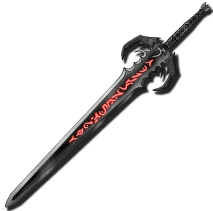 I created this intelligent sword for one of my campaigns. It was a lot of fun to play with.
I created this intelligent sword for one of my campaigns. It was a lot of fun to play with.